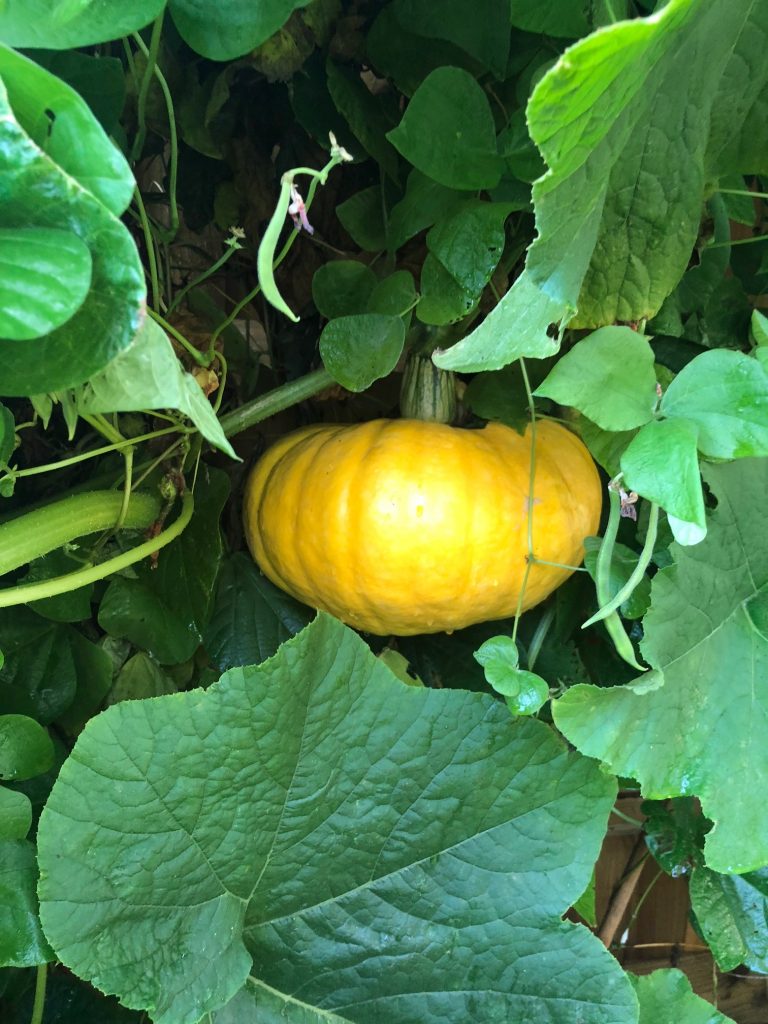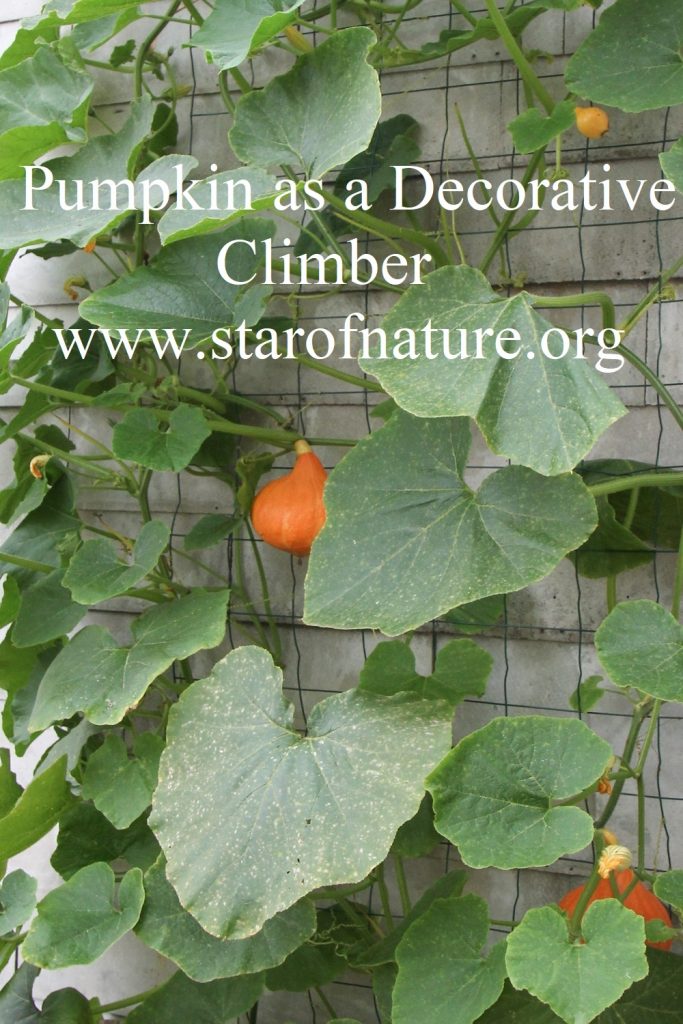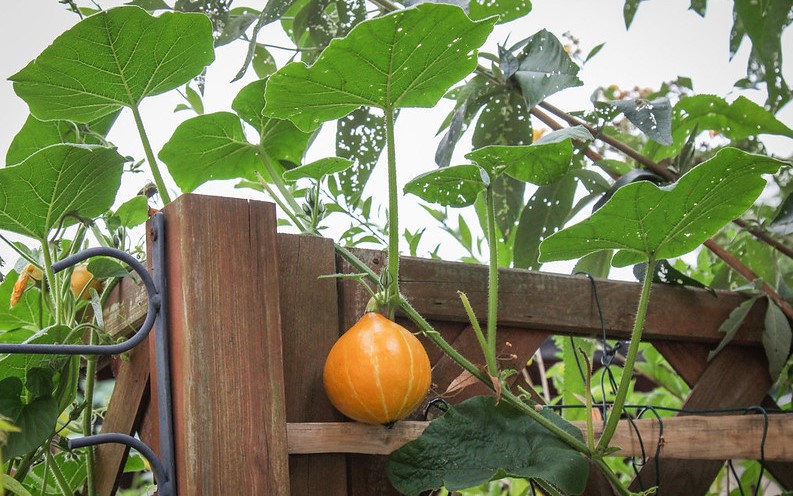Pumpkin as a Decorative Climber: the Useful and the Curious
Pumpkin has been a favourite with gardeners for a very long time as a vegetable and as an annual decorative climber. Old gardening books point out that it can be cultivated without much effort. Unlike cucumbers and tomatoes, pumpkins are perfectly happy to grow in open air.
Pumpkins’ light and soil requirements
Pumpkins’ most vital requirement is deep and rich soil, improved with compost and manure, where they can spread their roots and grow big. The soil should be also moist – in dry soil the plants will be week and quickly decline.
Another important requirement is the sun. Ideally pumpkins should be grown away from buildings and trees in an open position, exposed to the sun all day. This second requirement, however, is less vital in my experience.
I had pumpkins sprouting in a shady corner of the garden next to a compost bin. The seeds came no doubt from last year’s kitchen waste. Because the soil there was moist and very rich, there was no end to the plants’ energy, strength and vitality.
Before I had a chance to notice, they climbed up a fence and into the roof of the neighbours’ shed. They also spread to a vegetable bed and climbed up supports for beans. In both places they eventually got the full sun they wanted. They also developed multiple shoots, reaching from shade into the sunny areas of the lawn.
All plants produced large beautiful fruit. The photograph below shows a small part of that pumpkin jungle: hanging fruit of a plant that climbed on beans. It eventually grew so heavy, that I could not believe that bamboo-cane supports and the plant itself withstood its weight.

Pumpkin as ornamental annual climber
18th– and 19th-century gardening books often recommend growing pumpkins over structures, such as arches and gazebos. There they can be enjoyed as decorative plants and, if necessary, create shade and privacy.
This seems like an excellent suggestion. Pumpkins are indeed highly ornamental. They have large tropical-looking leaves and gorgeous flowers, loved by bees. Their fruit is of course beautiful too and comes in numerous shapes and colours.
Their ability to grow fast and climb tall structures in a single season is equal to none, as long as the soil is rich and moist. All this makes them a superb annual climber, beautiful, useful and great for wild life.
This ornamental aspect of pumpkins deserves more attention from gardeners. Particularly since gardens tend to be smaller today than they were in the past. These limited spaces have to be everything for a busy family: places to rest, socialize, play, as well as to grow your own food.
The lack of privacy in small gardens in densely build areas is another problem. But a fast-growing decorative climber can help with this too. All this makes easy to cultivate multi-taskers, like pumpkin, particularly valuable.
Garden history: advice for growing pumpkins from 18th– and 19th-century gardening books
I come across some very curious advice for growing pumpkins in 18th– and 19th-century gardening books.
1. Plant pumpkins after the full moon. They will produce better fruit and fewer male flowers than those planted when the moon is waxing.
2. Before planting, soak pumpkin seeds in milk, then put them in thick sugar syrup for 3-4 days. As a result, the fruit will be sweeter and plants less susceptible to cold.
3. To grow a very large pumpkin, wait until the fruit is of the size of a tennis ball, and make two or three holes in it by cutting out small segments. Put in the holes several mustard seeds as deep as possible, and close the holes with the cut-out segments. The fruit will grow very large, but will not taste as good as the smaller, more tender fruit.
4. It is possible to grow a pumpkin inside a house, as a decoration, by directing a vine through a small window. The growing fruit should be then positioned on a table or windowsill. As long as the flower has been pollinated, and the plant has good soil and enough water, the fruit will grow normal size.
Pumpkin flowers can of course be hand-pollinated with a soft brush, such a brush for cosmetics. I often do this with my courgettes and this makes the fruit much better. Until we have more pollinators, it is sadly almost a necessity.
For best results make sure that you cross-pollinate. Gently collect pollen with a brush from a flower of one plant and brush it on the pistil of a flower of another plant.
Pumpkin cosmetic recipe
To add to the usefulness of pumpkins, they are not only beautiful themselves, but can help to enhance our good looks as well!
To get rid of sun spots on the face, grind raw pumpkin seeds to a paste in a mortar. Add the same amount of water to make ‘milk’. Mix in some honey and put the mixture on the face for 30 minutes. Do it frequently until the spots disappear.
Image credits: featured image – by Maja Dumat; pin image Maja Dumat.
Posts related to ‘Pumpkin as a Decorative Climber: the Useful and the Curious’
Elecampane (Inula helenium): Ancient ‘Sunflower’ of Europe
How to Grow Winter Salad Leaves on the Patio
Natural Anti-Aging Cosmetics: 19th-century Recipes
Raspberry: a Perfect Fruit for Any Garden?
Pin ‘Pumpkin as a Decorative Climber: the Useful and the Curious’ for later

